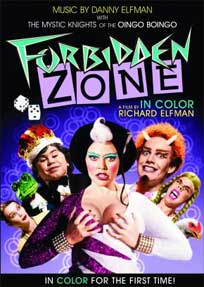 FORBIDDEN
ZONE (1980) (Colorized version)
FORBIDDEN
ZONE (1980) (Colorized version)Director: Richard Elfman
Legend Films
 FORBIDDEN
ZONE (1980) (Colorized version)
FORBIDDEN
ZONE (1980) (Colorized version)Why? It's the first question cult cinema fans ask whenever they hear plans to either remake or colorize a classic. Black and white cinematography can set a tone and develop a mood greater than any flashy camera work or expensive special effects, so why bother? When Legend Films released colorized versions of NIGHT OF THE LIVING DEAD and CARNVIAL OF SOULS, I avoided them like the plague and was fearful as to which of my favorites would befallen the trend next. On the other hand, I couldn't help but be curious about a colorized version of REFFER MADNESS. That any company would spend the time and money on such an offbeat title alone, garnered my attention. In the case of FORBIDDEN ZONE, if there were ever a valid case for adding color to a completed film, this just might fit the bill, as Legend Films' colorization and restoration process is the last step in achieving a director’s ultimate vision, over 25 years in the making.
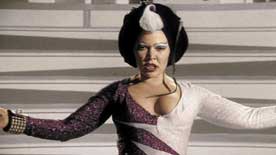
In the basement of the Hercules family home lies a portal into another dimension. Pa Hercules (Gene Cunningham billed as Ugh-Fudge Bwana) has forbid his children from passing through the cellar gateway as nothing but sin and corruption lay in wait on the other side. Attending her first day of school, 'Frenchy' Hercules (Marie-Pascale Elfman) discovers that one of her classmate's sister/brother has gone missing, having disappeared into the sixth dimension through the portal in her basement. Intrigued by the mystery that lies unguarded just below her feet, Frenchy cuts class and races home stumbling head first into the Forbidden Zone. Bewildered and intrigued by her new surroundings, it isn't long before Frenchy is captured and finding audience before King Fausto (Hervé Villechaize) and his Queen, Doris (Susan Tyrrell). The Queen immediately proclaims the young girl as an intruder and places her in confinement, sensing that her petite King has fallen in her fancy. Meanwhile back on our own astral plane, Frenchy's Grandpa (Hyman Diamond) and brother Flash (Phil Gordon) seek out the help of classmate Squeezit aka Chicken Boy (Matthew Bright), whose own sibling is also lost in the parallel world, to rescue Frenchy. Reluctantly, the trio make their way into the Forbidden Zone where they will have to evade Frog Butlers, a topless princess and Satan himself in order to rescue Frenchy from the diabolical clutches of Queen Doris.
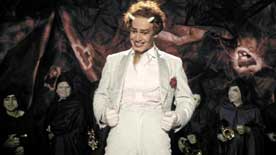 There's
not a lot of middle ground when discussing FORBIDDEN ZONE. For every fan who
finds the picture's Z-grade set design of crudely painted cardboard scenery
and cave walls made of black garbage bags endearing, there's another who finds
the film's oddball theatrics tiresome. Designed as a cinematic showcase for
the theatrical group The Mystic Knights of the Oingo Boingo, FORBIDDEN ZONE
is an amalgamation of crude grade school humor, trippy animation and inventive
musical numbers acted out by an array of eccentric and colorful characters.
Love it or hate it, FORBIDDEN ZONE is an unforgettable first look at a number
of current Hollywood players, both mainstream and underground. Most prominent
and prolific of which is director Richard Elfman’s little brother Danny.
Starting as Satan in one of the film's more enjoyable and catchy numbers, Danny
would eventually go on to become one of Hollywood’s most sought after
and recognizable film composers. Working on films ranging from SPIDER-MAN to
damn near everything Tim Burton touches, Danny's first score is a mixture of
avant-garde and Cab Calloway tunes that give strong hints to an illustrious
carrier to come.
There's
not a lot of middle ground when discussing FORBIDDEN ZONE. For every fan who
finds the picture's Z-grade set design of crudely painted cardboard scenery
and cave walls made of black garbage bags endearing, there's another who finds
the film's oddball theatrics tiresome. Designed as a cinematic showcase for
the theatrical group The Mystic Knights of the Oingo Boingo, FORBIDDEN ZONE
is an amalgamation of crude grade school humor, trippy animation and inventive
musical numbers acted out by an array of eccentric and colorful characters.
Love it or hate it, FORBIDDEN ZONE is an unforgettable first look at a number
of current Hollywood players, both mainstream and underground. Most prominent
and prolific of which is director Richard Elfman’s little brother Danny.
Starting as Satan in one of the film's more enjoyable and catchy numbers, Danny
would eventually go on to become one of Hollywood’s most sought after
and recognizable film composers. Working on films ranging from SPIDER-MAN to
damn near everything Tim Burton touches, Danny's first score is a mixture of
avant-garde and Cab Calloway tunes that give strong hints to an illustrious
carrier to come.
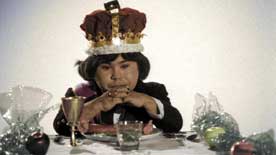
Hervé Villechaize would become a pop culture icon of the early 1980s thanks to his portrayal of Tattoo on “Fantasy Island”, his face becoming synonymous with the one-liner “zee plane boss, zee plane.” Susan Tyrrell, already well-established both on the small and silver screen, would find a niche for herself playing burly, often unconventional characters such as Ramona Rickettes in John Water’s CRY-BABY. Lovers both onscreen and off, Hervé and Susan have a noticeable, if not slightly disturbing chemistry that stands out among the mostly amateur cast. Susan in particular is a powerhouse as Queen Doris, who dominates every scene. Original Mystic Knight Matthew Bright, who both acts in and co-wrote FORBIDDEN ZONE, would go on to direct the 1990s cult hit FREEWAY staring Kiefer Sutherland and a young Reese Witherspoon, a contemporary twist on the tale of Little Red Riding Hood.
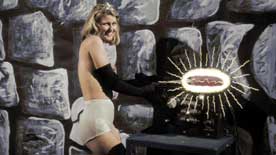 Writer/director
Richard Elfman originally intended to shoot FORBIDDEN ZONE in black and white
and then ship the print to China, where each frame would be hand colored to
achieve a specific cartoonish effect. Budgetary restraints obviously prevented
this from happening but, much like the Make-a-Wish Foundation, Legend films
have stepped up, lending their expert services to help achieve Richard’s
dream cut. Whether you're anti or pro colorization, one has to admit that Legend
has done an impressive job with this release. Colors rarely, if ever overwhelm
and there is a noticeable amount of restraint throughout the picture. While
there are a number of scenes that glow with bright pastels of color, the vast
majority of the picture is a wash of subdued and appropriate colors. Scenes
in the sixth dimension are still dark and gray with no attempt to hide or mask
the film's homemade setpieces. Numerous animated sequences in particular benefit
from the makeover and it is evident that Richard has worked very closely throughout
the process to achieve the desired look and feel that he had originally intended.
However with all that said, I still prefer the original black and white version.
There's a sense of gritty guerrilla filmmaking that is lost in the transfer
to color. The camp value and general feeling of mischief are still present,
but it just doesn’t feel as kinky as the original.
Writer/director
Richard Elfman originally intended to shoot FORBIDDEN ZONE in black and white
and then ship the print to China, where each frame would be hand colored to
achieve a specific cartoonish effect. Budgetary restraints obviously prevented
this from happening but, much like the Make-a-Wish Foundation, Legend films
have stepped up, lending their expert services to help achieve Richard’s
dream cut. Whether you're anti or pro colorization, one has to admit that Legend
has done an impressive job with this release. Colors rarely, if ever overwhelm
and there is a noticeable amount of restraint throughout the picture. While
there are a number of scenes that glow with bright pastels of color, the vast
majority of the picture is a wash of subdued and appropriate colors. Scenes
in the sixth dimension are still dark and gray with no attempt to hide or mask
the film's homemade setpieces. Numerous animated sequences in particular benefit
from the makeover and it is evident that Richard has worked very closely throughout
the process to achieve the desired look and feel that he had originally intended.
However with all that said, I still prefer the original black and white version.
There's a sense of gritty guerrilla filmmaking that is lost in the transfer
to color. The camp value and general feeling of mischief are still present,
but it just doesn’t feel as kinky as the original.
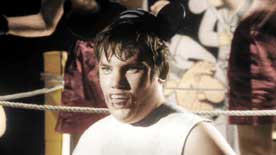
On hand in a near flawless 16x9 anamorphic widescreen transfer, Legend Films' presentation is definitely noteworthy. There is not a hint of debris or any blemishes present that might sidetrack the viewer from any of the crass and unconventional sequence of events. Audio is solid, giving justice to Danny’s first cinematic score and is available in either a 5.1 Dolby Digital or 5.1 DTS soundtrack.
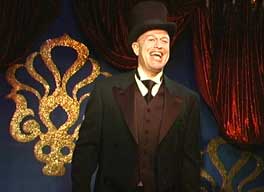 Fantoma,
through Ryko Distribution, released FORBIDDEN ZONE in its original black and
white back in 2004, with a number of impressive special features included therein.
If you’re a fan and already own this previous digital release, you’ll
want to hang onto it, as none of the special features have been ported over,
save for the film's original trailer and some deleted scenes which have been
colorized. It should also be noted that unlike the previous Fantoma release,
only the color version of the film is present here, so if like me, you prefer
the original black and white, there is yet another reason to hold on that release.
An introduction by Richard Elfman is accessible through the Special Features
menu. Richard is clearly ecstatic to finally be able to present his first feature
film in color as he had originally planned. A Japanese promo features Richard
touting his film dressed as a carnival barker and without question contains
the scariest visuals on this release. Richard's smile stretches eerily from
ear to ear and I don’t think he blinks once. Optional English subtitles
are available, as well as a pop-up trivia track which provide numerous interesting
and amusing facts about the production and its cast, but nothing that hasn’t
already been stated before on previous editions. (Jason
McElreath)
Fantoma,
through Ryko Distribution, released FORBIDDEN ZONE in its original black and
white back in 2004, with a number of impressive special features included therein.
If you’re a fan and already own this previous digital release, you’ll
want to hang onto it, as none of the special features have been ported over,
save for the film's original trailer and some deleted scenes which have been
colorized. It should also be noted that unlike the previous Fantoma release,
only the color version of the film is present here, so if like me, you prefer
the original black and white, there is yet another reason to hold on that release.
An introduction by Richard Elfman is accessible through the Special Features
menu. Richard is clearly ecstatic to finally be able to present his first feature
film in color as he had originally planned. A Japanese promo features Richard
touting his film dressed as a carnival barker and without question contains
the scariest visuals on this release. Richard's smile stretches eerily from
ear to ear and I don’t think he blinks once. Optional English subtitles
are available, as well as a pop-up trivia track which provide numerous interesting
and amusing facts about the production and its cast, but nothing that hasn’t
already been stated before on previous editions. (Jason
McElreath)